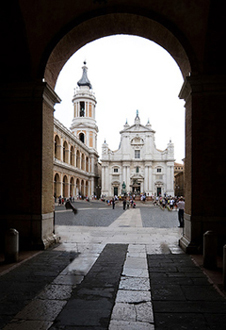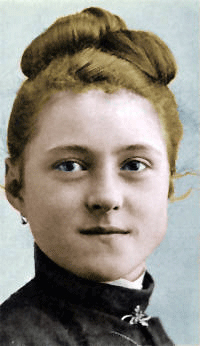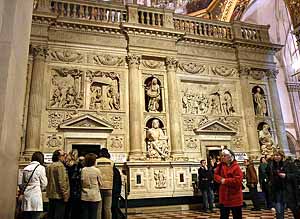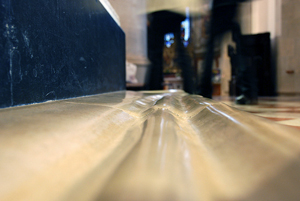 |
Catholic Customs
Visiting the Holy House of Loreto
Elaine M. Jordan
On a pilgrimage, a person often experiences a special grace or favor. Perhaps it is just a small thing, such as a gentile doorkeeper who smiles at us, opens a closed door of a sacred chapel and reveals to us a hidden relic of a Saint. In this or that way, Divine Providence arranges some significant little gesture that makes us feel Heaven is close to us, that the eyes of Our Lord and Our Lady truly never leave us and are always trying to draw us near.

The Basilica of Loreto built over the Holy House in the 15th century |
After I returned from a pilgrimage to the Holy House of Loreto – with my own special favor from Heaven - I recalled the experience of St. Therese of Lisieux in Loreto. She was on a pilgrimage to Italy with her father and her sister Celine, experiencing all the holy exhilaration a young girl feels in the holy places of Europe.
It is easy for me to imagine her and Celine furtively scratching a few pieces of stone from the wall of the Holy House, as she confesses, to take home as a sacred relic of the House where the Word became Flesh. I had tried the same thing, but was gruffly stopped by a guard.
Who can imagine the joy of St. Therese and Celine when they were allowed to receive Holy Communion – which was against the common practice – at the altar in the Holy House. It was a special smile from Heaven, that singular favor that Our Lord offers us as a small token of His immense goodness and prodigality. But I will let St. Therese tell you her experience at Loreto with her inimitable sweetness and charm. Then I will relate my own special grace I received at the Holy House of Loreto.
St. Therese’s favor
This is St. Therese’s account of her visit to the Basilica of Loreto. In her Autobiography, she writes:
“What shall I say about the Holy House? I was deeply moved to be under the very roof which had sheltered the Holy Family, and to be looking at the walls on which Our Lord had gazed, and walking on the ground once moistened by St. Joseph’s sweat, and to be where Mary had carried Jesus in her arms after carrying Him in her virginal womb. I saw the little room of the Annunciation, and I put my rosary in the dish used by the Child Jesus. I have very dear memories of it all.

St. Therese at age 15 |
“Our greatest happiness came when we received Jesus in His own house and became His living temple in the very spot glorified by His Divine Presence. It is the Roman custom that the Blessed Eucharist is received at only one altar in each church, and that the priest give Communion to the faithful only at that particular altar. At Loreto the altar is in the Basilica, which
encloses the Holy House like a casket of white marble around a precious diamond. This arrangement did not suit us at all. We wanted to receive the Bread of Angels in the diamond itself, not in its casket.
“Papa, docile as usual, went with the rest of the pilgrims, but his less docile daughters went into the Holy House. A priest who had a special privilege was getting ready to Mass there, so we told him what we wanted. And he at once asked for two Hosts and placed them on the paten. You can imagine the indescribable, wonderful joy of that Communion.
“What will it be like when we enjoy a never-ending Communion in the mansion of the King of Heaven? Then our delight will be without end and without a shadow. We shall not have to scratch fragments furtively from the walls made holy by the Divine Presence – as we did at Loreto – for His dwelling place will be our home throughout the ages. He lets us see his earthly home so that we may love poverty and the earthly life, but he conceals the palace where He dwells in glory. There we shall no longer see Him veiled under the appearance of an Infant or a host of Bread, but in the full light of his infinite splendor!”
My own favor at Loreto
The Holy House is a precious jewel encased in a magnificent setting. In 1469, Pope Paul II had a large Basilica with many individual chapels erected around the Holy House. Then, on the order of Pope Julian II in 1511, the House of the Virgin inside the Basilica was encased in marble carved with sculptures of personages and scenes from the Holy Gospel.

The Holy House was encased in ivory in 1511. Below, the deep furrows in the marble walkway surrounding the house.
 |
For some people, it is hard to believe that the translation of the Holy House from Nazareth to Tersatto (in Croatia), and then to its present location in Loreto is not pure fantasy. But there is one extraordinary proof. No house could stand for a long time – and certainly not for centuries – on the surface alone, without any foundation.
Yet during the pontificate of Benedict XIV in 1751, when restoration work was being done on the floor of the house, the architects and stonemasons confirmed this impressive fact: the walls of the Holy House were standing directly on the ground – without any foundation at all. And until today, it continues to stand without any foundation to sustain it.
Surrounding the Holy House is a marble walkway, and we were told that pilgrims used to pray on their knees going around the shrine. In fact, the millions who have made this devotional act have worn two shallow furrows in the hard stone. But I was visiting in the 1980s, after Vatican II, and the devotion was no longer being encouraged. In fact, two large heavy urns had been placed on the corners of the Holy House directly in the path of the marble walkway to discourage pilgrims from continuing that practice so irritating to Protestants and Progressivists.
I was very disappointed. How much I wanted to kneel on the furrowed marble and make my small pilgrimage around the Holy House, paying homage to the many holy events that took place in this marvelous dwelling. “My Heavenly Mother,” I prayed silently, “why can’t we make this beautiful devotion?”
At that moment, for some unknown reason, the guard was inspired to remove the large urns. How or why he came to do this I will never know. For me, it was a smile from Heaven, Our Lady telling me, “Look, my daughter, how I arrange things for you.”
I didn’t hesitate, but immediately began that blessed pilgrimage around the Holy House on my knees. It was my special grace at Loreto that I will always remember, a reminder of the goodness of Our Lady who pays heeds to even our small good desires.
Those nuggets of grace are worth more than gold, and we should carefully store them away and preserve them in our memories like a special treasure. Then, on dark days when the grace seem so distant, we can draw out these nuggets and recall those golden moments when Heaven seemed so near.

Posted January 5, 2009

Related Topics of Interest
 The Translation of the Holy House of Loreto The Translation of the Holy House of Loreto
 The Altar of the Heavens for the Santo Bambino The Altar of the Heavens for the Santo Bambino
 The Night of Christmas The Night of Christmas
 Mater Admirabilis: A Goodness that Has No Limits Mater Admirabilis: A Goodness that Has No Limits
 Snowflakes Reflect the Diversity of God Snowflakes Reflect the Diversity of God
 The Symbol of the Crown in the Reign of Mary The Symbol of the Crown in the Reign of Mary

Related Works of Interest
|
|
Catholic Customs | Religious | Home | Books | CDs | Search | Contact Us | Donate

© 2002- Tradition in Action, Inc. All Rights Reserved
|
 |
|